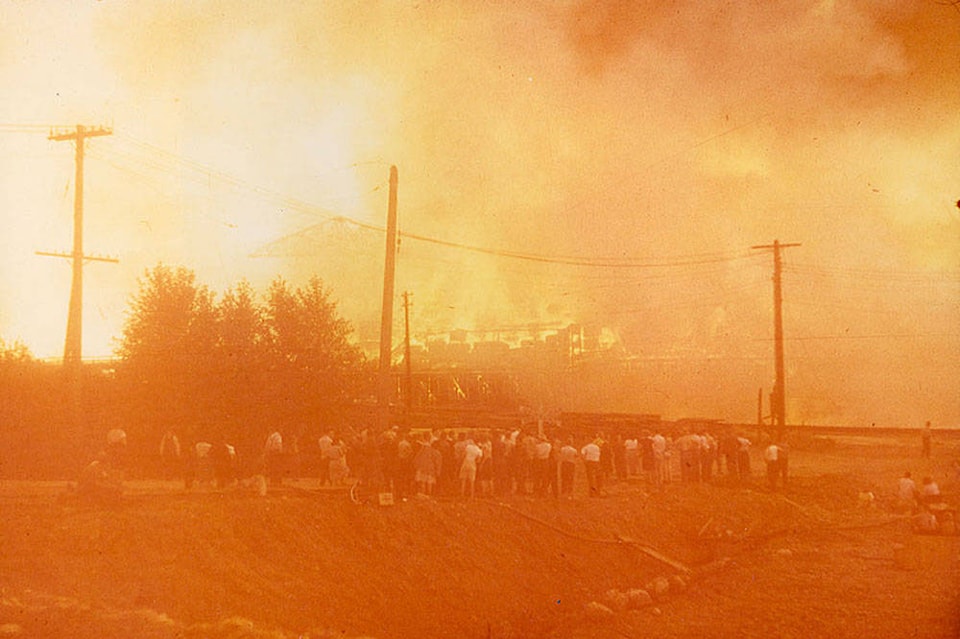In 2011-12 I participated in the centennial book project, helping to write portions of The Albernis: Then and Now, 1912–2012. One of the things that struck me about the history of the city, particularly its waterfront, is the number of fires that razed sawmills and how quickly everyone moved on.
One such fire was the Gilroy Mill, which opened on the waterfront where the Port Alberni Port Authority sits today as the Coal Creek Lumber Company Ltd. in 1918. It was sold in 1920 to W.A. Gilroy and T.G. McKay and renamed Gilroy and McKay Lumber Company. Within a year it burned down, and was replaced by a shingle mill.
In researching items for our Look Back feature, I’ve discovered even more of those stories. (If you’ve seen the historical photos in the Look Back feature that run on our editorial page in every print edition, you should watch for the feature online as well—it always has more information as well as a link to the online digital archive.)
There are two fires I’ve read about (so far) that stuck with me, and I thank historian and author Jan Peterson for her descriptions of them in her trio of books about Port Alberni. One of the fires is simply known as “The big fire.” It started as a slash fire east of Port Alberni in April 1924 and forced the closure of businesses. It started up again in a record sunny May, and again on July 4—this time distinguished as the “Dry Creek fire.” That one threatened businesses as far as where Canal Waterfront Park and Polly Point are today.
The second fire of note is the assembly wharf fire from 1947.
READ MORE: 1947 fire destroys Port Alberni wharf
In the mid-1920s both the coastal fishing and forestry industries were booming in the Alberni Canal, forcing the need for an assembly wharf on Port Alberni’s waterfront to handle all the activity. In Twin Cities: Alberni-Port Alberni Peterson writes about the debate that ensued over where to locate a wharf that would handle both commercial fishing and the lumber export market. The decision was made to build it near the (Alberni Pacific Lumber) APL sawmill on South Street.
The plan was ambitious: a main wharf measuring 400 x 100 feet, a second wharf about half that size, warehouses, a railway trestle, road and storage for several million feet of finished lumber. The cost at the time was $200,000 according to an article in the Port Alberni News.
Logging continued to thrive despite the Great Depression of the early 1930s, and in the late 1930s the assembly wharf was enlarged by 400 feet to accommodate lumber shipments.
The wharf was considered the “life-blood” of the district, so when it went up in flames on Aug. 28, 1947, it had a significant economic impact on the region. The fire was said to have cost $2 million in damages. Peterson devotes four pages to the fire, with detailed, descriptions from news coverage in the West Coast Advocate.
The fire started around supper time: witnesses saw flames in the warehouse section of the wharf, near shore. It was a bit windy at the time—as it gets down the inlet—and the wind quickly blew the fire out of control. Creosote on the pilings helped the fire to spread.
By 7 p.m., half an hour after fire crews arrived, the entire block—approximately 950 feet long—was on fire and “thousands of onlookers lined the waterfront to see the spectacular blaze that carried everything in its wake.” Witnesses said flames were shooting 200 feet into the air.
A 10,000-ton freighter, the S.S. Sampep, had been docked at the wharf and partially loaded with wheat and lumber. Despite efforts to cut it loose from the wharf, the ship burned in the middle of the inlet. It’s captain and crew members all abandoned ship and made it to shore.
Once the ashes settled, officials began rebuilding the wharf and it reopened two years after it burned down, on Aug. 25, 1949. The cost to rebuild was $500,000, or more than double what the original cost.
For the size of the fire, two years is admirably fast to rebuild. Can you imagine how long it would take and how much it would cost to rebuild the equivalent today?
— Susie Quinn is the Alberni Valley News editor and a history buff.
